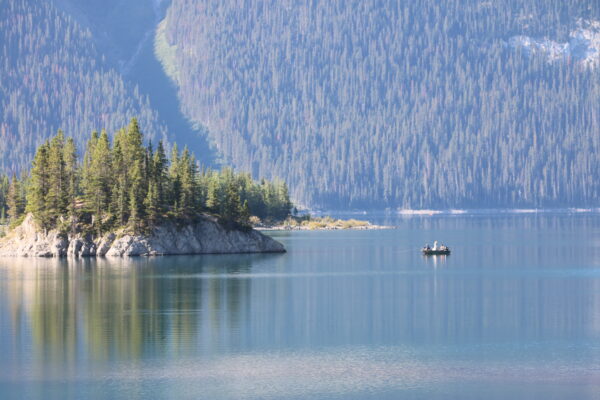Hiking Kananaskis Lakes: Your Complete 2025 Guide to Alberta’s Hidden Gems
📘 Table of Contents
What Are Kananaskis Lakes?
Kananaskis Lakes consist of two stunning alpine reservoirs – Upper and Lower Kananaskis Lake – nestled in Peter Lougheed Provincial Park within Alberta’s majestic Canadian Rockies. These pristine turquoise waters serve as the crown jewels of Kananaskis Country.
- Upper Kananaskis Lake: The larger and deeper of the two lakes at 111 metres deep, offering a spectacular 15.8-kilometre loop trail that showcases some of the most breathtaking mountain scenery in Alberta. The trail provides relatively easy hiking with only 295 metres of elevation gain, making it accessible for most fitness levels.
- Lower Kananaskis Lake: Features shorter interpretive trails perfect for families, with paved sections and excellent accessibility. The lake offers stunning views of Mount Indefatigable and Mount Invincible rising dramatically from the shoreline.
- Natural History: Originally natural lakes, both were expanded through hydroelectric development in the 1930s-1940s to help supply Calgary’s water reserves. Dead tree stumps visible in the water tell the story of this transformation.
- Location Benefits: Located just 90 kilometres west of Calgary in Peter Lougheed Provincial Park, these lakes offer all the beauty of the Canadian Rockies with significantly fewer crowds than Banff National Park.
The lakes sit at the heart of a 304-square-kilometre provincial park that ranks among Alberta’s largest protected areas. This wilderness playground attracts outdoor enthusiasts year-round with its combination of accessible beauty and challenging backcountry adventures.
How Do You Plan Your Hiking Kananaskis Lakes Adventure?
Planning your Kananaskis Lakes hiking adventure requires understanding permit requirements, choosing the right access points, and preparing for mountain conditions. The key to success lies in advance preparation and understanding the unique requirements of this protected area.
🚨 Essential: Kananaskis Conservation Pass Required
All vehicles parked in Kananaskis Country require a Conservation Pass since June 2021. Daily passes cost $15, annual passes $90 (covers 2 vehicles). Purchase online at alberta.ca and register your licence plate – no physical pass needed!
- Getting There: Drive Highway 40 south from Calgary for approximately 90 minutes, then follow Highway 742 (Kananaskis Lakes Trail) to reach the trailheads. The drive itself offers spectacular mountain scenery that builds anticipation for your hiking adventure.
- Parking Options: Upper Lake Day Use Area and North Interlakes Day Use Area serve as primary trailheads, with additional parking at Lower Lake facilities. Arrive early during peak season (July-August) as parking fills quickly on weekends.
- Facilities Available: Peter Lougheed Discovery Centre provides visitor information, washrooms, and Wi-Fi. Multiple day-use areas offer picnic tables, fire pits, and additional washroom facilities along the lakes.
- Cell Service Warning: Limited to no cell phone coverage throughout most of the park area. Download offline maps and inform others of your hiking plans before departing from areas with service.
For overnight adventures, the park offers seven automobile-accessible campgrounds plus backcountry camping options. The Point Backcountry Campground, accessible via the Upper Lake trail, provides a unique peninsula camping experience surrounded by pristine waters.
What Are the Best Hiking Trails Around Kananaskis Lakes?
The Kananaskis Lakes region offers diverse hiking experiences from easy family walks to challenging mountain scrambles. Each trail provides unique perspectives of the stunning alpine environment and varying levels of adventure for different skill levels.
🗺️ Interactive Kananaskis Lakes Trail Map
Click on trails, markers, or names below to learn more about each hiking option
- Upper Kananaskis Lake Loop (15.8 km): The signature hiking experience featuring continuous lakeside views, the challenging Palliser Slide rock crossing, and opportunities to spot wildlife. Plan 4-6 hours for the complete counter-clockwise loop, which showcases the most scenic sections first. Complete Guide →
- Rawson Lake Trail (7.4 km return): Branches off from the Upper Lake trail, this moderate hike leads to an emerald alpine lake nestled beneath Mount Sarrail. The trail features beautiful switchbacks through forest before opening to spectacular mountain cirque views. Complete Guide →
- Lower Kananaskis Lake Interpretive Trail (3.2 km): Perfect for families and those seeking easier terrain, this paved trail offers excellent mountain views and interpretive information about the area’s natural and cultural history. Complete Guide →
- Sarrail Ridge (from Rawson Lake): For experienced hikers seeking a challenge, continue beyond Rawson Lake up steep terrain to reach one of the area’s most spectacular viewpoints. This scramble requires proper preparation and mountain experience. Complete Guide →
💡 Pro Tip: Trail Connection Opportunities
Many trails interconnect, allowing you to customize your hiking experience. The Upper Lake trail connects to world-class hiking adventures that rival any destination globally!
Each trail offers different seasonal experiences, from vibrant wildflower displays in summer to golden larch colours in fall. The well-maintained trail system includes bridges, boardwalks, and clear signage to enhance safety and navigation.
When Is the Best Time for Hiking Kananaskis Lakes?
The optimal timing for hiking Kananaskis Lakes depends on your preferred activities and tolerance for weather conditions. Each season offers distinct advantages and unique experiences in this alpine environment.
- Peak Season (July-August): Warmest weather with temperatures reaching 20-25°C, all trails accessible, and vibrant wildflower displays in alpine meadows. Expect the largest crowds and fullest parking areas during this period.
- Shoulder Seasons (May-June, September): Fewer crowds, moderate temperatures, and stunning autumn larch displays in September. Some higher elevation trails may have snow patches early in the season requiring microspikes or light traction aids.
- Fall Colors (Late September-Early October): The golden larch season transforms the landscape into a photographer’s paradise. Cool crisp air and fewer bugs make for comfortable hiking conditions, though weather can be unpredictable.
- Winter Activities (November-April): While traditional hiking becomes challenging, the area transforms into a winter wonderland perfect for snowshoeing and cross-country skiing on groomed trails around the frozen lakes.
🌨️ Weather Considerations
Mountain weather changes rapidly! Even in summer, temperatures can drop suddenly and afternoon thunderstorms are common. Always check current conditions and be prepared for temperature swings of 15-20°C between day and night.
Free entry occurs on “Wilderness Wednesdays” – the first Wednesday of each month – making these ideal times for budget-conscious adventurers. However, popular trails may still be busy even on free days due to increased local interest.
What Should You Bring When Hiking Kananaskis Lakes?
Proper preparation ensures safety and enjoyment during your Kananaskis Lakes adventure. Mountain conditions demand specific gear and supplies, even for seemingly easy day hikes around the lakes.
🎒 Essential Hiking Gear Checklist
- Navigation: Downloaded offline maps, GPS device, and physical backup map
- Sun Protection: Sunglasses, sunscreen (SPF 30+), and hat for high-altitude exposure
- Insulation: Extra layers including warm jacket for temperature changes
- Illumination: Headlamp with extra batteries for early/late adventures
- First-Aid Supplies: Basic kit including blister treatment and pain relief
- Fire: Waterproof matches or lighter for emergency situations
- Footwear: Sturdy hiking boots with good ankle support for rocky terrain, especially important for the Palliser Slide section of Upper Lake trail. Consider bringing microspikes during shoulder seasons for icy conditions.
- Clothing: Layer system including moisture-wicking base layer, insulating mid-layer, and waterproof outer shell. Avoid cotton materials which retain moisture and lose insulating properties when wet.
- Food and Water: Bring more water than you think you need – mountain air and altitude increase dehydration. Pack high-energy snacks and a substantial lunch for longer hikes around the lakes.
- Bear Safety: Bear spray is essential in this active wildlife habitat. Learn proper usage and carry it in an easily accessible location, not buried in your backpack.
Consider bringing trekking poles for stability on uneven terrain and a camera with extra batteries to capture the incredible scenery. The dramatic mountain reflections in the lakes create photography opportunities that you’ll want to preserve forever.
How Do You Stay Safe While Hiking Kananaskis Lakes?
Safety in the Kananaskis Lakes region requires awareness of wildlife, changing weather conditions, and mountain hazards. This area hosts active populations of both black and grizzly bears, making proper precautions essential for all visitors.
🐻 Bear Country Safety Protocol
Kananaskis is active bear habitat! Make noise while hiking, travel in groups, carry bear spray, and know how to use it. Never approach or feed wildlife. Store food properly and report any bear sightings to park staff immediately.
- Wildlife Encounters: In addition to bears, the area hosts elk, moose, mountain goats, and wolves. Maintain minimum 100-metre distance from large mammals and never attempt to approach for photos. Loud voices and clapping help announce your presence on trails.
- Trail Conditions: Check current trail reports before departing as conditions change rapidly. The Palliser Slide on Upper Lake trail requires careful navigation across loose rock, and wet conditions make this section particularly challenging.
- Weather Hazards: Mountain weather develops quickly – afternoon thunderstorms pose lightning risks, especially on exposed ridge sections. Morning starts help avoid afternoon storm cycles common in summer months.
- Emergency Preparedness: Limited cell coverage means you’re on your own for emergencies. Travel with experienced partners, inform others of your plans, and consider carrying a satellite communicator for serious backcountry adventures.
The park’s remote location means rescue response times are extended compared to urban areas. Self-reliance and conservative decision-making become critical safety factors. When in doubt, turn back – the mountains will be there for another adventure.
What Else Can You Do Besides Hiking Kananaskis Lakes?
The Kananaskis Lakes region offers diverse recreational opportunities beyond traditional hiking, making it a complete outdoor destination for multi-day visits. These pristine waters and surrounding wilderness provide year-round adventure possibilities.
- Water Activities: Canoeing and kayaking provide unique perspectives of the surrounding mountains reflected in the lakes’ turquoise waters. Power boating, sailing, and windsurfing are permitted with proper equipment. Swimming is possible but water remains very cold year-round.
- Fishing Opportunities: Both lakes offer excellent angling for rainbow trout, cutthroat trout, and various other species. Alberta fishing licences are required for anyone over 16, and the lakes are regularly stocked to maintain healthy fish populations.
- Mountain Biking: Designated cycling trails include paved paths connecting campgrounds and moderate mountain biking routes. The Legacy Trail connects to Canmore and Banff, offering extended cycling adventures through spectacular mountain scenery.
- Winter Recreation: Cross-country skiing and snowshoeing transform the area into a winter wonderland. Groomed trails circle the frozen lakes, and the snow-covered landscape offers completely different but equally stunning scenery.
🏕️ Extend Your Adventure
Consider combining your Kananaskis Lakes experience with nearby adventures! Check out our Turbine Canyon hiking guide or explore backcountry camping opportunities for multi-day wilderness experiences.
Photography workshops and guided nature tours operate seasonally, providing educational opportunities to learn about the area’s natural and cultural history. The Peter Lougheed Discovery Centre offers interpretive programs and exhibits that enhance understanding of this remarkable ecosystem.
Conclusion
Hiking Kananaskis Lakes offers an unforgettable Canadian Rockies experience that combines accessibility with wilderness adventure. From the spectacular 15.8-kilometre Upper Lake loop to family-friendly interpretive trails, these turquoise alpine gems provide outdoor experiences for every skill level. Remember to purchase your Kananaskis Conservation Pass, pack bear spray, and prepare for changing mountain conditions. Whether you’re seeking challenging scrambles, peaceful lakeside strolls, or multi-day backcountry adventures, the Kananaskis Lakes region delivers world-class hiking just 90 minutes from Calgary. Start planning your 2025 adventure to discover why locals consider this Alberta’s best-kept outdoor secret!
Affiliate Disclosure
Some links in this post may be affiliate links. As an Amazon Associate and partner with other programs, I may earn a commission if you make a purchase, at no extra cost to you. I only recommend tools and gear I believe in.

